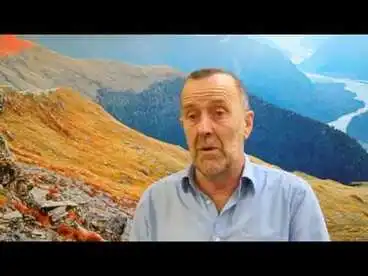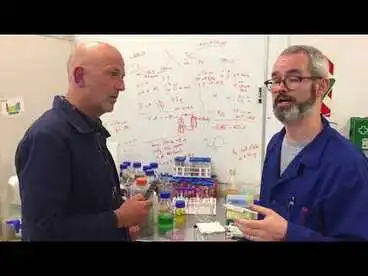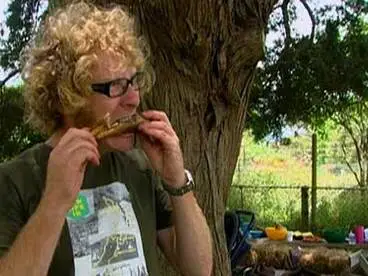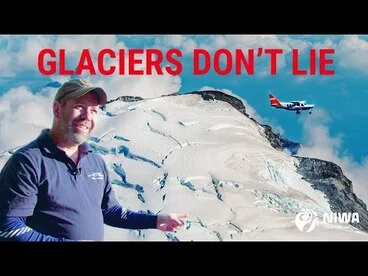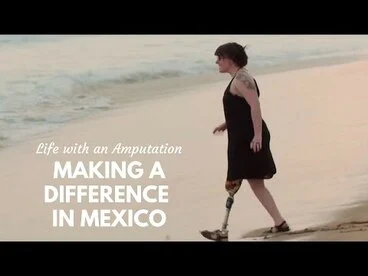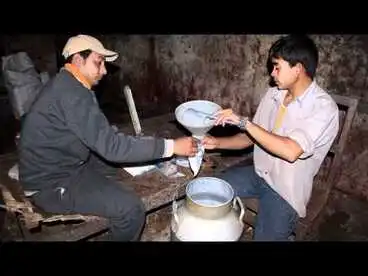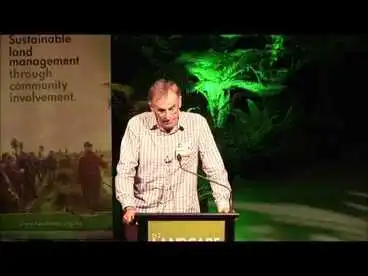Economic Sustainability
A DigitalNZ Story by National Library Services to Schools
It is even more crucial today that businesses develop a sustainable strategy. This story explores the concept of economic sustainability and its history with specific reference to New Zealand.
Sustainability, economic sustainability, economic growth, conservation, environmental issues, social science, science
"We cannot choose between (economic) growth and sustainability — we must have both." Paul Polman - Dutch businessman and leading voice on sustainable capitalism
New Zealand Business Council for Sustainable Development aim for zero waste
Manatū Taonga, the Ministry for Culture and Heritage
Background
On September 2015, world leaders at the UN General Assembly adopted 17 Sustainable Development Goals (SDGs). This meant that for the next 15 years, countries will take on the responsibility to develop economic strategies from combating poverty to caring for the planet, especially with respect to climate change
Economic sustainability plays a huge role in these development goals. It depends on the interaction between people, the economy and the environment – at all levels, from the global and national level to the local community and even to the individual.
Contents
This story on economic sustainability covers the following:
- What is economic sustainability?
- Measures for economic sustainability
- Land, oceans and rivers
- Renewable and non-renewable resources
- Sustainable consumerism
- Fairtrade for people and communities
- Sustainable business and innovation
- Cultural and economic sustainability
- Tourism
- Climate change
- New Zealand business organisations respond to climate change
- Glossary
- Supporting resources.
By 2009, sustainability became a mainstream business value
Manatū Taonga, the Ministry for Culture and Heritage
WHAT IS ECONOMIC SUSTAINABILITY?
Oxford Learner's Dictionary defines economics as the study of how a society organizes its money, trade and industry, and sustainability as the use of natural products and energy in a way that does not harm the environment.
Here are some definitions on economic sustainability:
"Economic – this aspect acknowledges the interactions of humans with the natural environment in using resources to create goods and services which add value to their lives. It acknowledges the resource use and waste disposal must occur within the capacity of our planet. It encourages a fair trading system that equitably distributes benefits and costs. It further encourages innovation and creativity in developments that lead to a sustainable future. " Aspects of sustainability on TKI from Ministry of Education.
"Economic sustainability refers to practices that support long-term economic growth without negatively impacting social, environmental, and cultural aspects of the community." University of Mary Washington
MEASURES FOR ECONOMIC SUSTAINABILITY
"Much of our economy relies on our natural environment, but can also have a negative impact on it. The challenge for New Zealand is to facilitate sustainable economic development while protecting ecosystems and the quality of our environment." Protecting people and the environment: Briefing to the Incoming Minister for the Environment Election 2005.
Ours not mine: No new mines on public conservation land
Forest and Bird
LAND, OCEANS AND RIVERS
Land, oceans and rivers have crucial roles in supporting our economy. However, they also need to be protected to preserve their equally important role in supporting and sustaining ecosystems and future generations.
Land
- Economic benefits: industry, agriculture, farming, and forestry.
- Sustainability measures: protection from biosecurity issues like pests and diseases, climate change, deforestation, overfarming, soil erosion, and pollution.
Rivers and lakes
- Economic benefits: urban and industrial use, domestic use, agriculture, power generation, recreation and tourism.
- Sustainability measures: policies and plans for careful management and use of water resources and protection from industrial, urban and agricultural waste.
Oceans
- Economic benefits: recreational activities, fishing, aquaculture, shipping, telecommunications, tourism, and offshore drilling for oil and gas.
- Sustainability measures: conservation and protection of marine and coastal ecosystems, protection from pollution, overfishing and threats from climate change.
QUICK FACTS
- Almost half of New Zealand's land is used for primary production such as agriculture (farming, dairying) and horticulture (fruit and vegetable growing).
- The agriculture industry has been a major cause of water pollution in New Zealand. The pollution comes from sediment (from deforestation), nutrients (from livestock and fertilizer) and bacteria (from livestock excrement).
- Ministry for Primary Industries has a Productive and Sustainable Land Use (PSLU) package to promote practises for farmers to use land for better economic and environmental outcomes.
- Over-fishing impacts on marine ecosystems by causing an imbalance in food chains that leads to the loss of other marine life, like vulnerable species from sea turtles to corals.
- Land-filling is the most common form of solid waste disposal.
Pohokura gas field
Manatū Taonga, the Ministry for Culture and Heritage
Anti Fracking protest, Wellington, May 2012
Alexander Turnbull Library
Urban water pollution
Manatū Taonga, the Ministry for Culture and Heritage
RENEWABLE AND NON-RENEWABLE RESOURCES
Renewable energy comes from sources that will not run out, such as the sun, water and wind. These can all be used to produce power for homes and industries, or fuel for transport.
Wind power
Wind is used to drive turbines that generate electric power. In 2004, 1% of New Zealand’s annual energy production came from wind. This was produced mostly from two ‘farms’ in the windy Tararua Ranges north of Wellington: the Tararua wind farm, with 103 turbines, and the Te Āpiti wind farm, with 55 turbines. Together they produce enough energy to power 75,000 homes.
Solar power
Solar energy (energy available from sunlight) is the most abundant form of renewable energy. This solar energy can be used to heat water, or converted to electricity. Around the country, solar power is also used for lighthouses and electric fences.
Source: Wind and solar power, Te Ara - the Encyclopedia of New Zealand, (accessed 6 May 2020).
Replacing non-renewable sources of energy with renewable sources is a strong step in the direction of economic sustainability.
Earth’s resources such as petroleum, gas, and coal are in limited supply. Use and reliance on these resources for economic development compromises environmental sustainability.
QUICK FACTS
- According to the United Nations, households consume 29 per cent of global energy and as a result, contribute to 21 per cent of CO2 emissions.
- Renewable energy produces less pollution.
- Burning of fossil fuels such as coal, gas and oil causes environmental damage.
- Tonga Renewable Energy Project under the Pacific Islands Renewable Energy Investment Program aims to shift Tonga from using fossil fuels to renewable energy.
- Māori used heated water from the earth to cook, wash and warm themselves, centuries before New Zealand began turning geothermal energy into electricity.
Photograph of Whole House Reuse Item 057
UC QuakeStudies
Japan Series: Nio Solar Power Station - Shikoku
Museum of New Zealand Te Papa Tongarewa
Mining e-waste for gold using bacteria
Radio New Zealand
SUSTAINABLE CONSUMERISM
Department stores have been described as expressions of 19th- and 20th-century consumerism. In an era marked by increased leisure time, they offered a new experience of shopping as a pastime.
From the mid-20th century, shopping malls evolved as the new department stores. Like department stores, malls bedazzle with displays of goods, presenting them in stylish settings to encourage consumption. They offer many services and attractions, including food courts and cinemas, and feature special events to attract patrons.
Source: Department stores and shopping malls - Mall and department store culture, Te Ara - the Encyclopedia of New Zealand, (accessed 8 May 2020).
Sustainable consumerism is about kaitiakitanga (guardianship) of the land. Ethical consumers make informed decisions about:
- buying and using products and services that have the least impact on the environment,
- buying products that are ethically produced,
- reducing food miles
- producing waste within sustainable limits.
QUICK FACTS
- Galleria Vittorio in Milan, Italy is one of the world's original and oldest shopping mall, while LynnMall in Auckland's suburb of New Lynn is New Zealand's first shopping mall. It opened in October 1963.
- Around 1.7 billion people worldwide belong to the affluent consumer class.
- Consumerism has a devastating effect on the earth's environment and its natural resources.
- The 'throw-away' mentality was developed by the mass manufacture of single-use products and cheaply made goods.
- Black Friday referred to the 1869 crash in the gold market in the US. Today it is an example of mass consumerism as crowds flood stores to buy heavily discounted goods. It is the biggest shopping day of the year in America.
Fashion and Pollution
Radio New Zealand
Off the Radar - Is Modern Christmas Sustainable?
NZ On Screen
Sustainable shopping
Radio New Zealand
FAIRTRADE FOR PEOPLE AND COMMUNITIES
Fairtrade means a guaranteed fair or minimum price, recognised and sustainable working conditions, and fair terms of trade for producers, farmers and workers in developing countries. For fairtrade to be economically sustainable, there needs to be an equal sharing of benefits and costs in a way that it is not harmful to the environment.
QUICK FACTS
- Fairtrade was started in response to the problems faced by Mexican coffee farmers following the collapse of world coffee prices in the late 1980s.
- Chocolate, coffee, tea, cotton, vanilla and bananas are some of the basic Fair Trade products available today.
- World Fairtrade Day falls on every second Saturday of May. It is a day to celebrate the contribution of Fairtrade to sustainable development, economic empowerment of small producers, gender inequality and responsible production practices.
- 25% of all farmers and workers in Fairtrade are women.
- There are over 3000 Fairtrade certified products available in New Zealand and Australia.
Consumers believe more retailers will buy into Fairtrade
Radio New Zealand
Fairtrade Banana Wars
Public Address
SUSTAINABLE BUSINESS AND INNOVATION
To be economically sustainable, businesses should encourage new, creative ideas that besides bringing in profits, also benefit society or the environment in some sustainable way.
QUICK FACTS
- Swedish furniture maker IKEA has invested in sustainability throughout its business operations. Around 50 % of its wood comes from sustainable forests.
- Green business industries use only sustainable materials, renewable energy and eco-friendly ways to create products.
- In May 2016 the Government of New Zealand announced its Electric Vehicle Programme to increase the number of electric cars in New Zealand.
- Move to Zero is sports-gear multinational Nike's commitment towards zero carbon and zero waste. They believe that protecting the planet will help protect sports from the impacts of climate change.
- The Great Bubble Barrier is a registered invention by Dutchman Philip Ehrhorn. It is a device laid on the bed of a river that pumps air through a tube that causes bubbles. These rising bubbles bring plastic to the surface, where it can be collected. It is not harmful to fish or passing ships.
Straight from the bean
Radio New Zealand
Honey and sustainability
Science Learning Hub
Loading Docs 2018 - What Logan Did
NZ On Screen
CULTURAL AND ECONOMIC SUSTAINABILITY
The Māori contribution to New Zealand’s farming economy is significant. In 2003 it was estimated that the annual agricultural and forestry production from Māori communally owned land assets was approximately $750 million, around 5% of the total. In the early 2000s more than 15% of the country’s sheep and beef exports came from Māori farming interests, and Māori owned around $100 million worth of shares in the huge dairy company Fonterra. Māori were farming 720,000 hectares in 2003 – mainly in sheep, beef and dairy.
Source: Ahuwhenua – Māori land and agriculture - Land ownership and Māori agriculture, Te Ara - the Encyclopedia of New Zealand, (accessed 28 May 2020).
Each country has its own tikanga (culture) which has strong historical relationships with land, family, customs and occupation. Economic groups like tourism, industry, agriculture that use land, sea and air need to work alongside indigenous peoples to allow for cultural, economic and environmental sustainability.
The Ministry for Primary Industries supports Māori agribusiness which promotes Māori primary sector assets (agriculture, horticulture, forestry and seafood). This in turn contributes to regional development, as well as the economy of the nation.
QUICK FACTS
- Approximately 370 million indigenous peoples occupy 20 per cent of the earth’s territory. Loss of land remains one of the biggest threats to indigenous people around the world.
- The Ministry for Primary Industries provides legislation for Māori customary fishing rights that are protected by the law under the Treaty of Waitangi and the 1992 Deed of Settlement.
- In 1963 the government established the New Zealand Māori Arts and Crafts Institute at Whakarewarewa — a geothermal Māori village and popular tourist destination. Although Māori still play an important role in promoting the culture, their ownership and management of the tourist destination has reduced considerably.
- New Zealand Māori Tourism (NZMT) represents more than 200 Māori tourism businesses that provide quality Māori cultural tourist experiences that contribute to New Zealand's economy.
Ngāi Tahu Seafood Group
Manatū Taonga, the Ministry for Culture and Heritage
Māori tourism at Whakarewarewa
Manatū Taonga, the Ministry for Culture and Heritage
Ahuwhenua trophy
Manatū Taonga, the Ministry for Culture and Heritage
TOURISM
Tourism was New Zealand’s top export earner in the year to March 2007, contributing 9.2% of gross domestic product. In 2008, for the first time, the combined spending of domestic and international tourists reached $20 billion a year. The concept of carbon footprints and the rising cost of fuel also intensified the idea that New Zealand was a distant place. To retain its profitability, Air New Zealand adjusted aircraft design and flying techniques and ordered fuel-efficient new-generation Boeing aircraft.
Source: Tourist industry - Challenges to the industry, Te Ara - the Encyclopedia of New Zealand, (accessed 8 May 2020).
Tourism provides a huge boost to economies around the world in terms of generation of income, employment and foreign-exchange earnings. To be sustainable, tourism would need to include conservation, preservation and protection of natural and manmade environments, reduction of carbon footprints, respect for cultural identities, and participation of local communities to ensure that financial benefits are shared and controlled domestically.
Two examples of tourism and kaitiakitanga (guardianship) in New Zealand Aotearoa:
- New Zealand-Aotearoa Government Tourism Strategy sets New Zealand’s goal for tourism to be sustainable to our environment, culture and the economy.
- Tiaki Promise, is an initiative by seven New Zealand organisations to encourage travellers to and within New Zealand to respect our culture, travel safely and mindfully while protecting our environment for the future.
QUICK FACTS
- The 100% pure New Zealand marketing campaign is now a recognised and well-respected tourism brand.
- One of the earliest attractions in New Zealand was the Pink and White Terraces, on the shores of Lake Rotomahana. They were considered to be the 8th wonder of the world. The terraces were destroyed when Mount Tarawera erupted in 1886.
- Tourism New Zealand is the government agency responsible for marketing New Zealand to the world as a tourist destination, but the Ministry of Business, Innovation & Employment's (MBIE) is responsible for making New Zealand's policy and rules on tourism.
- World Tourism Organization (UNWTO) is an agency of the United Nations that is responsible for the development of responsible and sustainable tourism.
- The COVID-19 pandemic had a huge impact on tourism in New Zealand, as well as around the world.
International tourists
Manatū Taonga, the Ministry for Culture and Heritage
Tourism operators question industry's sustainability
Radio New Zealand
"Clean, green New Zealand! Take only pictures, leave only..." 5 January, 2008
Alexander Turnbull Library
CLIMATE CHANGE
Climate scientists generally agree that the increase in global warming is a result of strong economic growth in:
- transport
- agriculture
- industry
- consumerism.
The Kyoto Protocol
Developed from the earlier United Nations Framework Convention on Climate Change, the Kyoto Protocol is an international agreement to address global warming and delay climate change. It aims to reduce the total greenhouse emissions of participating countries to below their 1990 levels by 2012. However, each country has its own target – New Zealand’s is to reduce emissions to the same level they were in 1990.
The Kyoto Protocol was designed as a first step towards a future with lower emissions. While targets beyond 2012 have not yet been agreed, it is clear that greater cuts in greenhouse gases and broader participation will be needed.
Source: Climate change - Global warming, Te Ara - the Encyclopedia of New Zealand, (accessed 8 May 2020).
The New Zealand government has been working with local councils and Māori to address climate change issues:
- Climate Change & Coastal Māori Communities is a project by Deep South National Science Challenge based around two Māori farms and a whānau trust. The project used iwi and hapū to guide community understanding and responses to climate change.
- Local Government New Zealand is leading a Climate Change Project that focuses on adaptation and reduction of impacts of climate change on the environment and economy of New Zealand.
QUICK FACTS
- Sea levels around New Zealand will rise by more than a metre by 2121 if global greenhouse gases are not reduced. This will result in massive coastal erosion, flooding and saltwater intrusion.
- In 2019 greenhouse gas emissions from transport made up 20% of New Zealand's total greenhouse gas emissions.
- Planting of trees called 'sinks' to absorb carbon dioxide from the air, was one of the examples provided by the Kyoto Protocol to help countries reach their emission targets.
- Forests take in large amounts of carbon dioxide and release oxygen into the air. This is why the huge Amazon rainforest is called the lungs of the earth. Sadly deforestation is taking place here to clear land for farming, roads, mining and dams.
- The burning of fossil fuels from the time of the Industrial Revolution in the 1760s started global warming and climate change much earlier than we realised.
"NZ signs Kyoto Protocol." 11 December, 2002.
Alexander Turnbull Library
Climate-change conference
Manatū Taonga, the Ministry for Culture and Heritage
NEW ZEALAND BUSINESS ORGANISATIONS RESPOND TO CLIMATE CHANGE
"While climate change is undoubtedly a very pressing environmental challenge, developing a truly sustainable nation also requires a broader focus on our economy and society and in the way we think about ourselves as a nation."
Helen Clark, Prime Minister of New Zealand, 8 May 2007.
In 2008 Rio Tinto Zinc threatened to close their New Zealand operations if they had to pay for emissions.
Manatū Taonga, the Ministry for Culture and Heritage
Climate change, environmental degradation and increasing awareness of sustainability practices provided new impetus for business organisations in the 1990s and 2000s. In response, new organisations were created like the New Zealand Business Council for Sustainable Development and the Sustainable Business Network.
These groups were willing to see New Zealand at the forefront of climate change and environmental response. Other business organisations argued that New Zealand should follow rather than lead. The Greenhouse Policy Coalition, Business New Zealand and the Business Roundtable predicted damage to the economy and businesses from too fast a response. Businesses working in this economic arena include:
New Zealand Business Council for Sustainable Development
The New Zealand Business Council for Sustainable Development (NZBCSD) was formed by a group of well-known business people in 1999. The council promoted sustainability in business, arguing that it contributes to social progress, ecological balance, protects quality of life and also enables profit-making.
Sustainable Business Network
The Sustainable Business Network, set up in 2002, amalgamated three small groups: the Environmental Business Network, Businesses for Social Responsibility and Triple B. Its purpose was the embedding of sustainable business practices in New Zealand.
Greenhouse Policy Coalition
The Greenhouse Policy Coalition was formed in 1996, and represented almost all of New Zealand’s largest users of power. Its members included New Zealand Steel, New Zealand Aluminium Smelters, Solid Energy, Fonterra, Methanex New Zealand and four pulp and paper manufacturers.
In 2009 the coalition argued that implementing the Kyoto Protocol on climate change was a significant risk to New Zealand’s economy. It called for a moderate and measured response by government.
Business New Zealand and the Business Roundtable
In relation to climate change, Business New Zealand emphasised the need to safeguard economic growth while attempting to limit greenhouse gas emissions.
In 2009 the Business Roundtable accepted that climate change was occurring, but argued that New Zealand should not limit greenhouse gas emissions until Australia had done so.
Source: Employer and business organisations - Business organisations and climate change, Te Ara - the Encyclopedia of New Zealand, (accessed 1 May 2020).
QUICK FACTS
- The main cause of climate change is the accumulation of GHG (Greenhouse gas) in the atmosphere. New Zealand's share of GHG may be small, but total emissions per person is high. New Zealand's emissions mainly come from the burning of fossil fuel that gives out CO2 (carbon dioxide) and agriculture what gives out CH4 (methane) and N2O (nitrous oxide).
- In November 2019 New Zealand lawmakers passed a bill in parliament that commits the country to be carbon neutral by 2050.
- New Zealand ratified the Kyoto Protocol in December 2002.
- In late 2019 the New Zealand government along with the primary sector and iwi / Māori decided to equip farmers and growers with the tools to reduce emissions while continuing to produce food and fibre for the domestic and international markets.
Selling carbon credits
Manatū Taonga, the Ministry for Culture and Heritage
Green building
Manatū Taonga, the Ministry for Culture and Heritage
Farming and environmental pollution
Science Learning Hub
Glossary
Definitions below have been taken from the Oxford Learner's Dictionary.
aquaculture — the practice of growing plants in water or farming fish for food.
biosecurity — the activities involved in preventing the spread of animal and plant diseases from one area to another.
carbon footprint — a measure of the amount of carbon dioxide that is produced by the activities of a person or company.
domestically — inside a particular country; not abroad or internationally.
emissions — the production or sending out of light, heat, gas, etc.
food miles — a measurement of the distance food has to be transported from the producer to the consumer and the fuel that this uses.
global warming — the increase in temperature of the earth’s atmosphere that is caused by the increase of particular gases, especially carbon dioxide.
indigenous — belonging to a particular place rather than coming to it from somewhere else.
innovation — the introduction of new things, ideas or ways of doing something.
Nisbet, Alastair, 1958- :'Okay guys...are we prepared to enter fresh water? splutter!' 18 October 2012
Alexander Turnbull Library
Tararua wind farm
Manatū Taonga, the Ministry for Culture and Heritage
SUPPORTING RESOURCES
EPIC— find more information on this topic on EPIC. Databases recommended: Australia New Zealand Reference Centre Plus, Science (Gale in Context) and New Zealand Geographic Online. (School login may be required).
MTG: What is economic sustainability? — a video from More Than Green explains the basics of economic sustainability.
Stitches— May looks at the economic benefits that a new sewing machine will bring to her life.
Sustainable development— a document from the Ministry for the Environment on the connections between the environment and the economy and environment and society.
Sustainable development facts for kids — sustainable development includes a better environment, economy and better social conditions.
Sustainable development for New Zealand — New Zealand seeks to achieve the United Nation’s Sustainable Development Goals (SDGs) in the public sector, private sector and civil society.
Sustainable development goals — 17 Sustainable Development Goals from the United Nations to transform our world.
What is a sustainable economy? — a definition of a sustainable economy, and new economic strategies to create sustainable economies.
LAND, OCEANS AND RIVERS
Ancient Native-American methods for sustainable oyster harvests — Smithsonian scientists experiment with a sustainable model for future oyster restoration.
Rethinking innovation for a sustainable ocean economy — OECD (Organisation for Economic C0-operation and Development) report emphasises the importance of science and technology in improving the sustainable economic development of oceans and seas.
Sustainable water programme of action — a staged package of actions to improve the sustainable management of New Zealand’s freshwater resources.
Waterfront Auckland — the transformation of the waterfront to benefit sustainable development in environmental, social, cultural and economic terms.
What is sustainability — a definition of sustainability and what that means for the building industry.
RENEWABLE AND NON-RENEWABLE RESOURCES
Can 100% renewable energy power the world? — politics, infrastructure and technology to make renewable energy cost-effective and sustainable.
NZ plugs into electric cars — New Zealanders are collaborating on a world-first research project that tracks their electric vehicles.
Restricting the production of fossil fuels in Aotearoa New Zealand— the environmental and economic impacts of New Zealand’s decision to not grant any new petroleum prospecting, exploration and mining permits outside onshore Taranaki.
FAIRTRADE FOR PEOPLE AND COMMUNITIES
Fairtrade for producers — economic benefits and sustainability for producer organisations, workers and farmers active in Fairtrade.
10 ways Fairtrade helps advance the sustainable development goals – minimum price, fair standards, decent work for all are some ways that Fairtrade advances towards Sustainable Development Goals (SDGs).
What Fairtrade does— the role of Fairtrade for farmers and workers in developing countries.
What is sustainable development?— the role of Fairtrade in support of 17 sustainable development goals.
SUSTAINABLE CONSUMERISM
Economic impacts of GM crops — a question about genetically modified (GM)food crops being good or bad for farmers and consumers.
History: Consumerism — the political, economic and social history of consumerism.
The future of food — the need for farmers and consumers to work together on sustainable food production. Read this article from New Zealand Geographic Online available through EPIC. School login maybe required.
Responsible consumption and production — infographics, facts, figures and targets from the United Nations on sustainable consumerism.
SUSTAINABLE BUSINESS AND INNOVATION
The business logic of sustainability — carpet company owner, Ray Anderson shares his vision for sustainable commerce.
Brundtland Report — also called Our Common Future, this report released in 1987 by the World Commission on Environment and Development (WCED) explained the concept of sustainable development and how it can be achieved.
Economic sustainability for success — what is economic sustainability and how to implement it.
The fourth industrial revolution— what it means, and the response needed for it to be sustainable.
Growing green dollars with eco enterprises— Rangatahi (youth) in Northland and Wellington are learning how to build businesses based on protecting native wildlife.
Sustainable business and living — institutions, social processes and tools needed by the public sector and society to accept opportunities and meet challenge of a changing world.
The issue of our time — urges New Zealand and the global economy to move away from business-as-usual and towards ecologically sustainable principles based on social justice.
The new organisation helping finance environmental action— Toha aims to bridge the gap between finance and environmental action.
CLIMATE CHANGE
He waka eke noa - our future in our hands — New Zealand climate change commitment.
An interview with the climate change-obsessed CEO of NZ’s biggest petrol company— what’s it like to be a climate change campaigner in a big oil company.
Surviving climate change means transforming both economics and design — designers need a shift in economic priorities to be able to design sustainable future ways of living.
TOURISM
The growth paradox: can tourism ever be sustainable? — the essential balance between sustainable tourism and economic growth.
Inflight waste diverted from landfill — Air New Zealand diverts more than 890 tonnes of in-flight waste as part of its Project Green initiative.
The environmental consequences of projected tourism growth — the need for the tourism sector to work towards sustainable economic and environmental goals.
CULTURE
Culture for sustainable development goals — one of the 17 universal United Nations goals for sustainable development.
Sacred ground – inside the Dakota pipeline protests – lack of consultation with Sioux Tribe led to a campaign against the laying of oil pipelines across their sacred land.
Social and economic benefits of partnerships for Aboriginal people — Aboriginal joint management of parks benefits not only local Aboriginal communities but the whole community.
Te tāpoi Māori - Māori tourism — the story of Māori tourist industry, economic benefits and the impacts of the loss of land and power of control of tourism
NEW ZEALAND BUSINESS ORGANISATIONS AND CLIMATE CHANGE
BusinessNZ — New Zealand's business advisory group at the local and national government.
Sustainable Business Council — the New Zealand Business Council for Sustainable Development (NZBCSD) was formed by leading businesses with a shared commitment towards sustainable development.
Sustainable Business Network — organisations that connect through events, resources and projects to help New Zealand become a sustainable nation.
WBCSD – World Business Council for Sustainable Development aims to maximise positive impacts for shareholders, the environment and societies.
From the Ground Up - Sustainable Fodder Systems for Improving Incomes in Nepal
Plant & Food Research
PET plastic recycling process
Science Learning Hub
This story was curated and compiled by Te Puna Mātauranga o Aotearoa | National Library of New Zealand, Services to Schools staff, April 2020.


